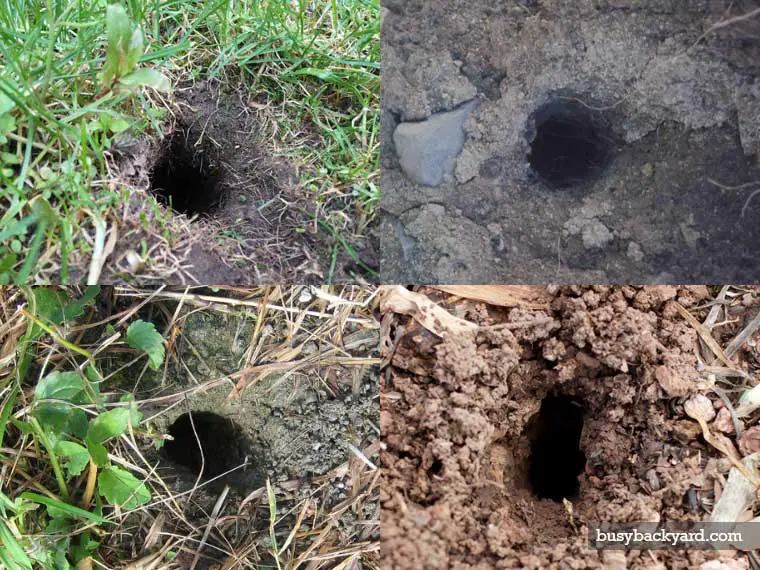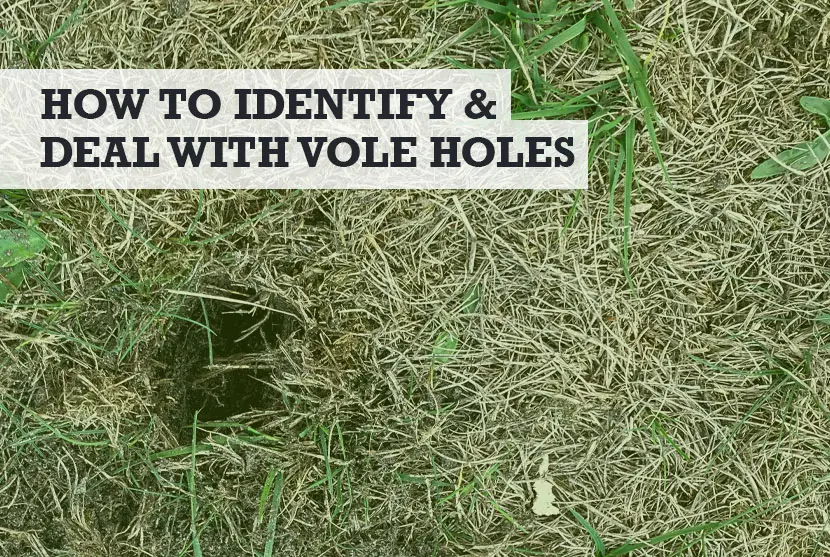This guide will show you how to identify vole holes in your yard, lawn, or garden (for UK visitors). I will also show you what voles looks like with images and pictures, plus how you can get rid of them… should you wish to do so.
What do vole holes look like in a yard?
As a rule of thumb, vole holes are about the size of a golf ball (1.7 inches in diameter). It is easy to confuse them with the holes of other critters, and some will often confuse them for snake or chipmunk holes.
Aside from the size of vole holes, here are some other ways to identify them in your backyard.
What vole holes look like in your yard
- Vole holes do not have mounds of earth outside them like mole holes do.
- Voles are about the size of a golf ball, and just under 2 inches in diameter.
- They are found on yards and lawns and often around the base of trees.
- You might also notice tracks that about 2 inches wide in the lawn where the voles are travelling between holes.
- Look for gnaw marks near the bottom of trees, bark, or plant stems.
- Look for dead plants that have had their roots eaten.
- Vole tunnels can go as deep as 12 inches into the earth.
Without seeing a vole hole though, you still might not be 100% certain. To help you, here are some photos, then below, all you need to know about how to deal with them.
Vole holes in yard (images)

Are voles bad for your yard?
Before you think about getting rid of the vole holes in your yard, consider whether it’s a bad thing. For many gardeners the most pressing concern can be the aesthetics of holes and track lines left in your lawn – not great if you’ve spent a lot of time and money on it.
It’s not unheard of for vole tunnels to collapse up to a foot deep. That can mean you risk turning an ankle the next time you walk in your backyard.
Other considerations will be how badly voles strip from bark from trees you’ve grown. They will also thrive on smaller plants and kill off what you’re trying to grow from seeds and bulbs in pots and garden beds.
You can protect trees in your yard from voles by wrapping tree trunk protectors (view on Amazon).
Voles also love to eat root systems. You won’t know they have burrowed under the earth to get at plants until it’s too late and they are dead.
What’s not often considered is how voles can spread disease and possibly introduce parasites to yards. According to the UK government website, voles carry hantaviruses.
“Hantaviruses are a group of viruses that are normally carried by rodents, such as rats, mice, and voles. They are present throughout the world, and they cause a range of diseases in humans ranging from mild, flu-like illness to severe respiratory illness or haemorrhagic disease with kidney involvement.”
But that doesn’t mean voles are always bad for a yard, they can offer some benefits. For example, if you like wildlife in your garden such as owls and foxes, then voles will attract them. Voles can also help to keep certain insects and weeds in check.
Do voles cause house damage?
Perhaps the most important reason you might want to get rid of vole holes in your yard is the possible damage they can create near property foundations.
Backyard vole holes lead to tunnels that can be as deep as 12 inches. If those are burrowed under concrete paths, patios, and home foundations, it can lead to structural issues.
How to get rid of vole holes
The best way to get rid of vole holes and tunnels is to make the voles leave your yard. Before we go on, I don’t advocate killing creatures in my guides, so prefer humane methods. However, that’s not to say I won’t explain the non-humane ones (I will further down).
However, if you do want to get rid of the vole holes in your backyard, please try to make them vacate first before plugging, flooding, of filling the tunnels.
Below are methods to put in place to your lawn stops attracting voles to your yard, and ways to help keep them away, or coming back to dig more holes and tunnels.
What attracts voles to your yard?
Understanding what attracts voles to your lawn or garden in the first place is the best step you can take to prevent vole holes in your yard.
Backyard lawns and gardens make the ideal home for these small rodents, as they offer lots of places to hide, abundant food sources. Gardeners hate voles as they can decimate seed supplies, blubs, and cherished plants.
This can become a bigger problem if voles have no predators on your property and their population explodes. This then means the voles are more likely to become a nuisance as they feed on more plant material that has been purposely grown.
Whilst voles are omnivores, they prefer plant material. They will only eat meat when it’s opportunistic, in other words, when they find dead animals on the ground. Aside from that, your yard will be a veritable feasting ground for them.
Voles are also attracted to yards that have healthy and well-watered, damp lawns as well as warm compost piles you might have in corner of the garden.
It’s also very likely that you have more voles in your yard than you think. They are very shy and are nocturnal, so won’t be a critter you are likely to see during the day.
Voles are also higher in number in backyards during fall (autumn) months and can cause a lot of damage to lawns in winter by digging their hole and tunnel systems.
How to deter voles from your yard
Make sure you keep your garden lawn mowed to no longer than an inch and cut back any messy vegetation that offers them places to hide or take cover from predators. Clear up any cut grass, mulch, or loose wood piles as these offer great places for voles to hide and start digging holes.
Keen gardeners should not leave seeds and bulbs outdoors before they become too mature. Grow them indoors (like these Brussel sprouts), and only bring into the yard once established.
If you do have to plants seeds and bulbs outdoors, cover them with a fine wire netting (6.5mm). I also recommend wrapping netting around the stems of young saplings and plants.
By doing so, you are removing at least one possible food source for backyard voles, which will hopefully help deter them from digging more holes in your lawn. You can also try ultrasonic repellent spikes. These are stuck into the ground and emit sonic pulses which annoy voles and keep them away. You can buy them on Amazon.
What do voles eat in your yard?
Removing specific food source will help to deter and get rid of vole holes. The specific things that voles are eating in your yard or garden could include:
- Plants
- Grass lawns
- Seeds
- Bulbs
- Carrion
- Fallen fruit
- Nuts
- Pet food
- Roots
By removing access to those food sources, it will have the knock-on effect of helping to get rid of vole tunnels and holes being dug in your garden.
What do voles eat in the winter?
Whilst a lot of your garden plants might not thrive as much in winter, voles still will. Cutting their food source in winter is also important to keep voles away from your yard. The Northumberland Wildlife Trust explain the following:
“Voles collect underground stores of vegetation to feed from throughout the winter, made up of high energy and long-lasting items such as tubers, roots and bulbs. However, if there is a mild spell of weather, they may also venture out of their burrows occasionally to forage, favouring nutrient and energy dense things like willow bark.”
What are voles eaten by in the wild?
Another way to get rid of vole holes is to encouraging wild predators of voles such as owls, hawks, falcons, coyotes, bobcats, foxes, raccoons, snakes, weasels, and lynxes.
For most people, inviting animals onto their property will come with different challenges, so domestic cats are a far better option as these will eat voles in your yard.
Let nature take its course.
Will coffee grounds get rid of voles?
Another way to discourage voles digging holes in your garden lawn or yard is to put down smells that keep them away. Some people say coffee grounds are great for this, but what is the truth?
Unfortunately, there is no scientific evidence to prove that coffee grounds get rid of voles. There are far better ways, all of which are listed below so please keep reading!
Does apple cider vinegar repel voles?
Again, there is no absolute proof that apple cider vinegar repels moles, but I have heard more anecdotal stories that it works. Some gardeners will make a mix with water and spray it on and near plants that have vole damage.
I’ve also heard of mothballs being used which can be scattered around backyards where vole holes are present.
What smells keep voles away?
Pest management companies will be the best people to ask this, so that’s exactly what I did. I canvassed the opinion of three local companies to me, and these are the smells they told me could keep voles away from a backyard:
- Castor oil
- Cedar
- Mix hot peppers with water and biodegradable dish soap
- Peppermint
- Rosin
How do you lure out a vole?
If all else fails, and you still can’t get rid of your backyard vole holes, you could lure them out before trapping them humanely.
One pest company I spoke to swore smearing peanut butter mixed up with some oatmeal. They explained how this would lure voles out of their holes at night into humane traps.
How to trap voles?
Aside from the peanut butter and oatmeal trick, you can also put cut up apple and carrot into traps for voles. But be aware, voles are not trapped easily like mice are, they take a bit more work.
In my experience, the best way to trap voles is to place humane tunnel traps outside their holes. You can buy these on Amazon (or click the image below).
Leave them about a foot away from the vole holes in your yard or garden, bait them with the food that voles like to eat, then check them again the next morning. It might not work on the first night, so persevere for a week at least.
Once you have trapped the voles in your backyard, take them at least a mile away from your home. If you don’t, they might come back to the holes in your lawn.
Homemade vole poison ideas
If all else is lost and the only way you can get rid of voles in your yard is to use a nuclear option, then you might be considering homemade ideas. That’s all well and good, but honestly, the best poison is to use bait chunks like these ones on Amazon.
There’s a great video below which shows how to do it.
How to fill vole holes in a yard
Once you have got rid of the voles, you can fill the holes. There are several ways in which you can start plugging vole holes in a yard. Some people will recommend you flood them, which can make voles come out, but it won’t fill them.
The best thing to put into vole holes is topsoil – but only providing you have got rid of the critters first.
Here’s how to repair your lawn after voles have been expelled from the holes, including repairing the tracks (runways) they might have created on the grass.
1. Get raking
Voles leave runways on lawns as well as feces and mess. Rake over the grass to expose their tracks and holes. This will also help to promote future lawn growth.
2. Fill tracks and holes with topsoil
First you will need to find the tunnels created by the voles. I do this by pushing my heel in and around the holes and following any tunnels that then collapse. Once identified, topsoil can be pushed into the tracks, tunnels, and holes.
3. Rake and seed the area
Rake over it all to create a smooth lawn, then spread grass seed over the affected areas. Also add slow-release organic to encourage growth.




